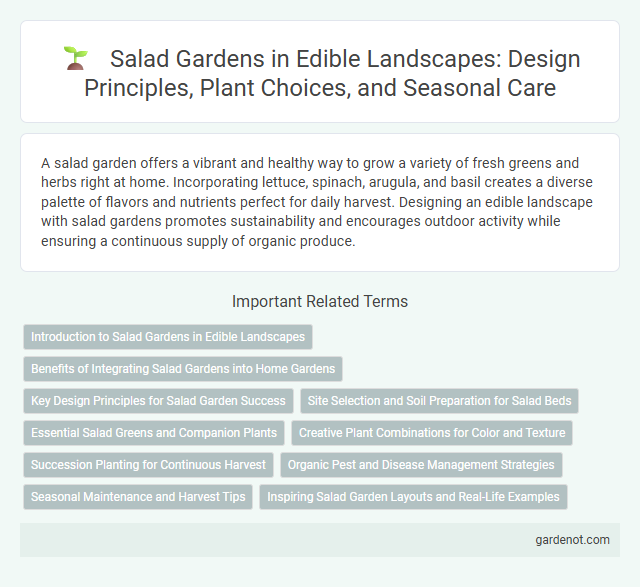A salad garden offers a vibrant and healthy way to grow a variety of fresh greens and herbs right at home. Incorporating lettuce, spinach, arugula, and basil creates a diverse palette of flavors and nutrients perfect for daily harvest. Designing an edible landscape with salad gardens promotes sustainability and encourages outdoor activity while ensuring a continuous supply of organic produce.
Introduction to Salad Gardens in Edible Landscapes
Salad gardens in edible landscapes combine diverse leafy greens, herbs, and edible flowers to create visually appealing, nutritious, and easy-to-harvest outdoor spaces. Incorporating varieties like arugula, spinach, kale, and basil enhances both flavor complexity and seasonal harvests. Sustainable practices such as companion planting and organic soil enrichment optimize growth while supporting ecosystem health.
Benefits of Integrating Salad Gardens into Home Gardens
Integrating salad gardens into home gardens enhances access to fresh, nutrient-rich vegetables like lettuce, spinach, and arugula, promoting healthier eating habits. Growing salad greens at home reduces grocery costs and environmental impact by minimizing packaging and transportation emissions. Home salad gardens also support biodiversity by attracting beneficial insects and improving soil health through diverse plantings.
Key Design Principles for Salad Garden Success
In designing a salad garden, selecting diverse leafy greens such as arugula, spinach, and kale ensures a continuous harvest and varied flavors. Implementing companion planting with herbs like basil and chives enhances pest control and promotes healthy growth. Prioritize well-drained, nutrient-rich soil combined with adequate sunlight of 6-8 hours daily to maximize plant vitality and yield.
Site Selection and Soil Preparation for Salad Beds
Optimal site selection for a salad garden requires full sun exposure, well-drained soil, and proximity to a water source to ensure consistent moisture levels. Soil preparation involves testing for pH balance between 6.0 and 7.0, incorporating organic matter such as compost to enhance fertility and structure, and loosening the soil to promote root development. Properly prepared salad beds support vigorous growth of leafy greens like lettuce, arugula, and spinach, maximizing yield and flavor.
Essential Salad Greens and Companion Plants
Essential salad greens like arugula, romaine, and butterhead lettuce thrive in edible landscapes, providing fresh, nutrient-rich leaves throughout the growing season. Companion plants such as radishes, carrots, and edible flowers like nasturtiums enhance growth by attracting beneficial insects and deterring pests. Integrating these greens and companions in a salad garden improves biodiversity, soil health, and continuous harvests for home gardeners.
Creative Plant Combinations for Color and Texture
Combining leafy greens like arugula and red leaf lettuce with vibrant Swiss chard and kale creates a dynamic salad garden full of contrasting colors and textures. Incorporating herbs such as basil, cilantro, and edible flowers like nasturtiums adds bursts of flavor and visual appeal. Using a mix of crisp, tender, and slightly bitter plants enhances both the aesthetic and sensory experience of an edible landscape.
Succession Planting for Continuous Harvest
Succession planting in a salad garden ensures a continuous harvest by staggering sowing dates of leafy greens like lettuce, arugula, and spinach every two weeks. This method maximizes yield in small edible landscapes, providing fresh, nutrient-rich salad greens throughout the growing season. Implementing succession planting techniques enhances garden productivity and reduces gaps between harvests in home salad gardens.
Organic Pest and Disease Management Strategies
Organic pest and disease management in salad gardens relies on integrated techniques such as crop rotation, companion planting with pest-repellent herbs like basil and chives, and the use of natural predators including ladybugs and lacewings. Implementing organic-approved treatments like neem oil, insecticidal soaps, and diatomaceous earth helps control aphids, caterpillars, and fungal infections without harming soil health or beneficial insects. Regular monitoring and maintaining optimal soil fertility through compost and mulch strengthen plant resilience against common diseases like downy mildew and damping-off.
Seasonal Maintenance and Harvest Tips
Salad gardens thrive with regular seasonal maintenance, including consistent watering during dry periods and mulching to retain soil moisture and control weeds. Pruning outer leaves promotes continuous growth and prevents bolting, ensuring a steady supply of tender greens. Harvest early in the morning when leaves are crisp, using sharp scissors to avoid damaging the plants and encourage regrowth throughout the growing season.
Inspiring Salad Garden Layouts and Real-Life Examples
Salad garden layouts prioritize efficient use of space through companion planting and succession planting techniques, maximizing harvests of leafy greens, herbs, and edible flowers. Incorporating raised beds, vertical trellises, and intercropping with fruiting plants enhances biodiversity and aesthetic appeal, promoting a sustainable edible landscape. Real-life examples include urban balcony gardens featuring mixed lettuce varieties alongside cherry tomatoes and microgreens, exemplifying practical, visually striking salad garden designs.
Salad garden Infographic

 gardenot.com
gardenot.com